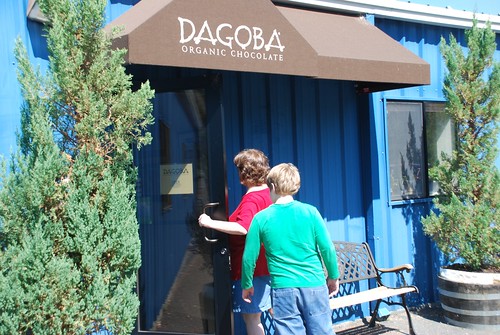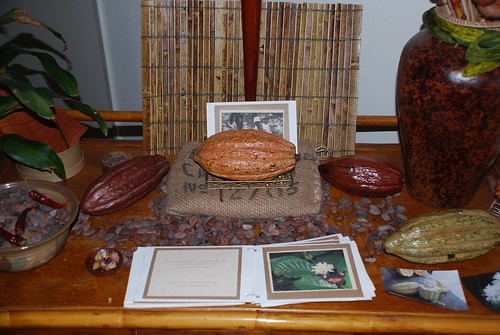We stopped at Dagoba on a hot August day, and Kim & Charlie preceded me into the cool tasting room:

Sadly, no factory tours were available, due to FDA regulations (their factory has no separation between the tourists and the chocolate vats). But we were able to console ourselves with tastings, and with an interesting display of cacao pods and beans in the raw:

Dagoba (and it's pronounced da-GO-ba, from the Sanskrit word for "temple"—NOT to be confused with a certain swamp planet in a galaxy far, far away) has a fairly comprehensive line of chocolates, including various powdered cocoa products as well as confectionery bars. The bars are available for tasting, on two separate tables; I'll describe each individually.
The first table contains a selection of chocolate bars with different flavors, including several straight-up dark chocolates. We ended up buying the Conacado, a 73% chocolate from cacao sourced in the Dominican Republic. Rich, bittersweet and deep, it's a good choice for anyone familiar with the better-quality chocolates from Sarotti and Valrhona.
We also picked up a bar of Latte, a milk chocolate with ground coffee and cinnamon, Charlie's favorite combination ever since he discovered Mexican chocolate (which includes ground cinnamon). This one's creamy, with the warm spice of cinnamon and the faint bitterness of coffee, an excellent treat.
Another classic combination is their mint, dark chocolate with mint and a hint of rosemary. Rosemary? Yes, and the choice of this evergreen herb is wonderful with dark chocolate and the bright, wintery zing of mint. Even better to our palates was the Lavender: dark chocolate with lavender and blueberries. The flowery fragrance of lavender on top of the slightly tart blueberry undertaste makes this exotic and luscious. There were more chocolates to choose from, but we turned our attention to the other tasting table for something more subtle.
That subtlety: varietal chocolates, from Peru, Ecuador, Costa Rica, and Madagascar. We especially liked the Madagascar, an intensely flavored dark chocolate (65%) with a strong mineral backbone (as they say in wine circles), earthy and robust with hints of citrus. We also came home with the Ecuador Arriba, a more flowery chocolate but still with the strong astringency that real dark-chocolate lovers crave. I was also fond of the Costa Rican Cru Trinitario (68% cocoa), with elements of golden raisins and hazelnuts in the finish.
But one of my favorite things about Dagoba chocolate is that they are 100% organic and fair-trade, which has two benefits. First: for those who have been disturbed by the growing outrage over the use of slave labor in the production of West African chocolate (page will open in new window), Dagoba's organic certification means that the cacao beans were grown and harvested without slave labor. Additionally, since slavery is still used in western Africa, Dagoba's use of Central and South American chocolates (plus some Madagascar beans) avoids the issue entirely.
And second: their organic methods really break into the new buzzword of "sustainability." The model of sustainability focuses on a type of agriculture which puts back nutrients into the soil, avoids pollution of water sources, and reduces the negative impact on the ecosystem in which the agriculture takes place. For Dagoba, this means that the cacao trees grow in their natural habitat (like shade-grown coffee), not in clearcut plantations. This means that the cacao farms retain the native plants used as nesting and food sources for migratory songbirds and other rain-forest animals. In short... this chocolate may be brown, but in its heart it's green.
Best of all is the story from Madagascar, one of the world's most fragile ecosystems. Biodiversity in and around the cacao farms is actually increasing, rather than decreasing, since Dagoba has started contracting for cacao pods from the Sambirano region. Given that 80% of Madagascar's species live nowhere else on earth, the news that sustainable cacao farming is restoring and preserving these subtropical forests is very encouraging.
But at the end of the day, intellectual arguments over fair trade and sustainability fade in comparison to Dagoba's real strength: the chocolate is just superb. Whether it's the unsweetened powdered cocoa (which we've been using in mochas now that the school year has resumed) or the exquisite bars of chocolate, Dagoba deserves the attention of serious chocolate lovers anywhere.

